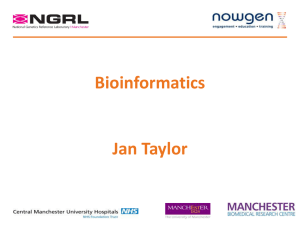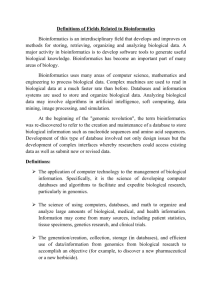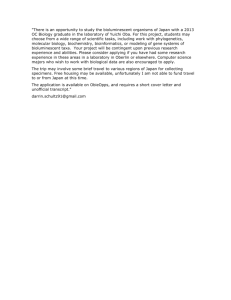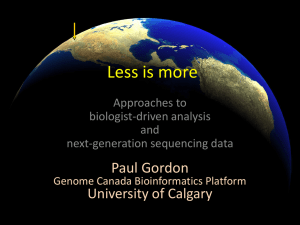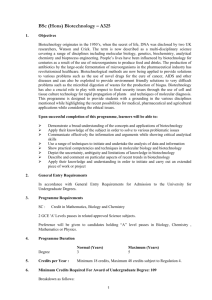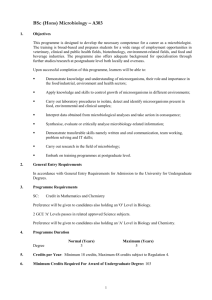MSc Biotechnology and Bioinformatics
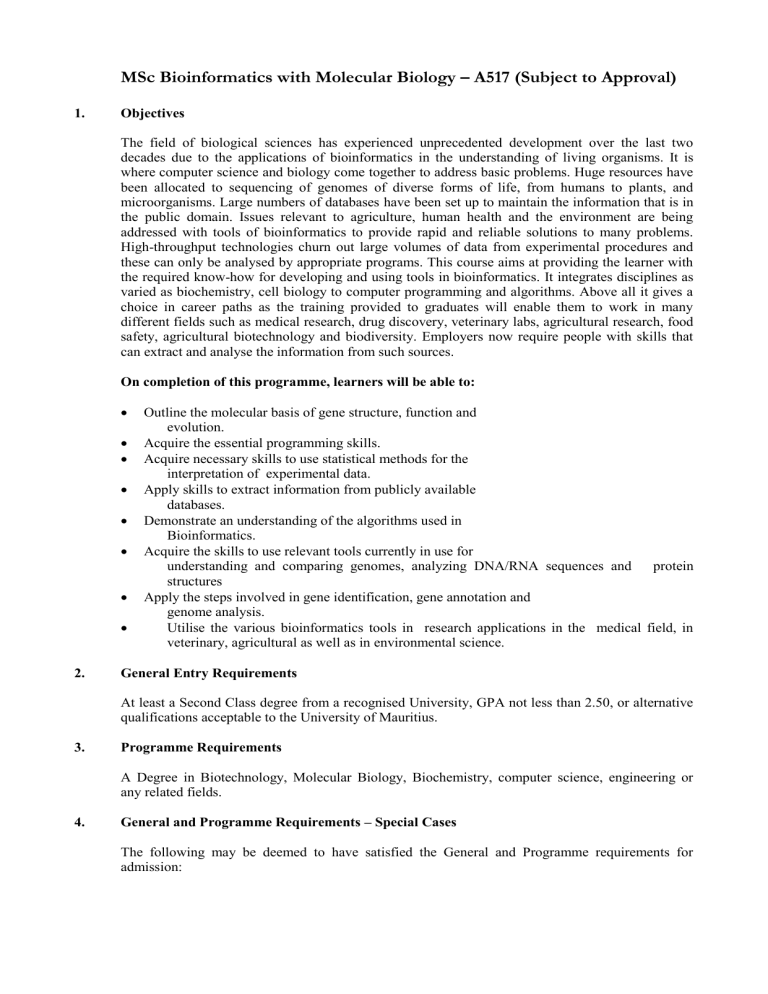
MSc Bioinformatics with Molecular Biology – A517 (Subject to Approval)
1. Objectives
The field of biological sciences has experienced unprecedented development over the last two decades due to the applications of bioinformatics in the understanding of living organisms. It is where computer science and biology come together to address basic problems. Huge resources have been allocated to sequencing of genomes of diverse forms of life, from humans to plants, and microorganisms. Large numbers of databases have been set up to maintain the information that is in the public domain. Issues relevant to agriculture, human health and the environment are being addressed with tools of bioinformatics to provide rapid and reliable solutions to many problems.
High-throughput technologies churn out large volumes of data from experimental procedures and these can only be analysed by appropriate programs. This course aims at providing the learner with the required know-how for developing and using tools in bioinformatics. It integrates disciplines as varied as biochemistry, cell biology to computer programming and algorithms. Above all it gives a choice in career paths as the training provided to graduates will enable them to work in many different fields such as medical research, drug discovery, veterinary labs, agricultural research, food safety, agricultural biotechnology and biodiversity. Employers now require people with skills that can extract and analyse the information from such sources.
On completion of this programme, learners will be able to:
Outline the molecular basis of gene structure, function and evolution.
Acquire the essential programming skills.
Acquire necessary skills to use statistical methods for the interpretation of experimental data.
Apply skills to extract information from publicly available databases.
Demonstrate an understanding of the algorithms used in
Bioinformatics.
Acquire the skills to use relevant tools currently in use for understanding and comparing genomes, analyzing DNA/RNA sequences and protein structures
Apply the steps involved in gene identification, gene annotation and genome analysis.
Utilise the various bioinformatics tools in research applications in the medical field, in veterinary, agricultural as well as in environmental science.
2. General Entry Requirements
At least a Second Class degree from a recognised University, GPA not less than 2.50, or alternative qualifications acceptable to the University of Mauritius.
3. Programme Requirements
A Degree in Biotechnology, Molecular Biology, Biochemistry, computer science, engineering or any related fields.
4.
General and Programme Requirements – Special Cases
The following may be deemed to have satisfied the General and Programme requirements for admission:
5.
6.
7.
8.
9.
(i) Applicants who do not satisfy any of the requirements as per Regulations 2 and 3 above but submit satisfactory evidence of having passed examinations which are deemed by the Senate to be equivalent to any of those listed.
(ii) Applicants who do not satisfy any of the requirements as per Regulations 2 and 3 above but who in the opinion of Senate, submit satisfactory evidence of the capacity and attainments requisite to enable them to pursue the programme proposed.
Programme Duration
Master’s Degree (FT):
Master’s Degree (PT):
Postgraduate Diploma (FT):
Postgraduate Diploma (PT):
Normal [months)]
14 months
36
12
24
Credits per Year: Minimum 12 credits subject to Regulation 5.
Maximum [months]
20
40
24
48
Minimum Credits Required for the Award of
Master’s Degree:
36
Postgraduate Diploma: 24
Postgraduate Certificate 12
Breakdown as follows:
Master’s Degree:
Core Taught Modules Project
24 credits 12 credits
Assessment
Each module will carry 100 marks and will be assessed as follows (unless otherwise specified):
Assessment will be based on written examination of 3-hour duration for all modules, and continuous assessment which will be based on case studies; Problem-Based Learning, visits, student-led seminars, and literature based research and/or assignments, and should include at least 1 class test.
The modules carrying 3 credits will be assessed at the end of the semester while the 6-credit modules will be assessed at the end of the year. Projects will be assessed in December of the final year.
For a student to pass a module, a minimum of 40% for combined continuous assessment and written exam, should be attained in that module.
There will be a compulsory class test for the module taught over a semester at the end of the semester of the given academic year. Written examinations for all the modules, will be carried out at the end of each semester.
Submission Deadlines for Dissertation:
First Draft:
Final Copy:
End of October in the Final Year.
Last working day of November in the Final Year.
Important Note
The rules as stipulated in this Programme Structure and Outline Syllabus will replace all other rules and regulations.
10. List of Modules
CORE MODULES
Code Module Name
AGRI 6053Y(1) Molecular biology, gene and genome analysis
CSE 6096(1) Algorithms for Computational Biology
CSE 6097Y(1) Data resource management and Biostatistics
AGRI 6056Y(1) High throughput technologies and systems Biology
AGRI 6057Y(1) Genomics and transcriptomics
MED 6001(1) Bioinformatics Applications in Research
AGRI 6000Y(1) Project
Total no. of credits: 36
11. Programme Plan MSc Bioinformatics with Molecular Biology
Full-time:
Code
YEAR I
Module Name
CORE
AGRI 6053Y(1) Molecular biology, gene and genome analysis
CSE 6096 Y(1) Algorithms for Computational Biology
CSE 6097 (1) Data resource management and Biostatistics
AGRI 6056 (1) High throughput technologies and systems Biology
AGRI 6057Y(1) Genomics and transcriptomics
MED 6001(1) Bioinformatics Applications
AGRI 6000Y(1) Project
Total no. of credits: 36
Part-time:
YEAR I
Code Module Name
CORE
AGRI 6053 (1) Molecular biology, gene and genome analysis
CSE 6096 (1) Algorithms for Computational Biology
CSE 6097Y (1) Data resource management and Biostatistics
YEAR 2
Code Module Name
AGRI 6056 (1) High throughput technologies and systems Biology
AGRI 6057Y(1) Genomics and transcriptomics
MED 6001 (1) Bioinformatics Applications in Research
AGRI 6000Y(1) Project
Total no. of credits: 36
Hrs/Yr
L+P
30+30
30+30
75+30
30+30
75+30
30+30
-
Credits
3
3
6
3
6
3
12
Hrs/Yr
L+P
30+30
30+30
75+30
30+30
75+30
30+30
Credits
3
3
6
3
6
3
12
Hrs/Yr
L+P
30+30
30+30
75+30
Credits
3
3
6
Hrs/Yr
L+P
30+30
75+30
30+30
Credits
3
6
3
12
12. Outline Syllabus
AGRI 6053Y(1) MOLECULAR BIOLOGY, GENE AND GENOME ANALYSIS
Gene and genomic structure, molecular processes underlying gene expression, gene and genomic evolution.
CSE 6096 (1) ALGORITHMS FOR COMPUTATIONAL BIOLOGY
Introduction to data structures such as graphs, linked lists and trees. Algorithm Complexity Analysis; Bioinformatics algorithms such as Dynamic Programming, Pattern matching, string searching and Graph searching.
CSE 6097(Y) (1) DATARESOURCE MANAGEMENT AND BIOSTATISTICS
To introduce important Computing concepts required by Bioinformaticians. Basic database concepts, use of
Databases for Bioinformatics, Data mining, Protein sequence and structure database, microarray database.
– To work out the essential statistical methods/techniques needed for the interpretation of experimental data.
Probability, Hypothesis testing, Likelihood ratio, matrices and models for phylogeny reconstruction.
AGRI 6056Y(1) HIGH THROUGHPUT TECHNOLOGIES AND SYSTEMS BIOLOGY
Analyze raw data using various bioinformatics, statistics, and data mining methods. Reconstruction of genetic circuits using results from the data analysis processes that are : genome sequencing, annotation and analysis.- Whole genome shot-gun sequencing. Genome variation, SNPs.Transcript profiling.Gene expression data analysis. Proteomics: Mass spectroscopy, 2-D Gel elctrophoresis, Protein chips, Metabolic profiling, pathways reconstruction, metabolic engineering, understanding of structure of the system, such as gene regulatory and biochemical networks.
AGRI 6057Y(1) GENOMICS AND TRANSCRIPTOMICS
To assist learners to interpret data emanating from genome projects and how to apply such data to real-life situations for problem solving. Genome annotation, gene organization, regulatory sequences, features of genomes. Using tools for genome analysis; comparative genomics, evolutionary genomics. Genome assembly and annotation; computational design and genomics prediction; bioinformatics predictive methods for gene finding and regulatory features; specific algorithms for sequence analysis, multiple alignments, heuristics and comparative genomics.
To illustrate the use of appropriate methods for measuring and analyzing gene expression data. Microarray,
SAGE, RealTime-PCR to understand fundamental biochemical processes and their control.
ESTs.
MED 6001Y(1) BIOINFORMATICS APPLICATIONS IN RESEARCH
Applications in genetic and epidemiological studies . Working with genomes of microbial organisms.
Vaccine development. Bioinformatics and its impact on Drug Discovery, Toxicogenomics and understanding mechanisms of Toxicity, Pharmacogenomics. including Medical Bioinformatics and
Haplotying, Genotyping and Population Genomics, Identification of susceptibility genes in common phenotypes of biomedical importance, Classification of tumours and identification of potential therapeutic targets against cancers using gene expression profiles, Clinical diagnostics, Role of bioinformatics in providing novel biological insights in pathogenic pathways with a potential for identification of therapeutic targets or of biomarkers that allow improved disease detection, monitoring of disease progression and treatment response. Challenges of genetic profiling in clinical practice, Medical Data Mining, Ethical considerations
AGRI 6000Y(1) PROJECT
The project provides an opportunity for the students to undertake and contribute to a piece of original research work in an area related to molecular biology and bioinformatics. The students will be required to design an investigation to test a hypothesis or proposition to plan and execute the research work to evaluate the outcomes and draw valid conclusions. The research work is carried out individually under guided supervision. To support the project work, the Faculty has prepared a document on: Dissertation Guidelines for MSc Degree
February 2010
